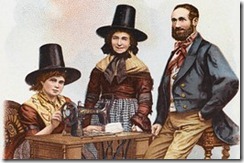When we were growing up, my mother sewed a lot of our clothing – the girls’ clothing that is.
The first items I remember wearing were when I was very young: white shorts and a navy blue dress coat (needless to say not worn together) made from material salvaged from my father’s WWII dress uniforms. This was in the mid-1950’s, so those unis must have been lying around in the cedar chest, surrounded by mothballs, for a good decade or so. Funny, I don’t recall any mothball odor. The material must have been thoroughly aired, blowing in the wind from the clothesline off the porch in our second floor apartment.
The navy blue Sunday coat stands out in my mind because it had very snappy red with white polka dots sateen lining.
The shorts stand out because my mother rarely made play clothes, which must have been cheap enough to buy, but focused on dresses.
The one other foray into sports clothes I recall was a few years later, when my mother stitched up a couple of extraordinarily dowdy bathing suits for my sister Kathleen and me. We were then in our pre-teen/early teen years. And if there’s one thing a girl of that age really wants is an extraordinarily dowdy bathing suit, let me tell you.
When other girls my age were wearing two-piece Madras suits taken from the pages of Seventeen, I was in a modest turquoise, black and white pique number that wouldn’t have been out of place on Eleanor Roosevelt. Pique is not exactly a fabric designed for a romp in the pool, but my sister Kath’s had it even worse. (At least I think it was hers. Maybe it was mine, and I’ve just gone into denial on it. Maybe one of us will have a recovered memory. I think I’m recovering mine now. Was that ticking suit mine? Could we both have had them?) It was made out of blue and white pillow ticking, bordered with red rick-rack.
Ticking! Ticking?
When the suit got wet, it would add about twenty pounds weight to you, which made swimming almost as difficult as if someone had slipped a cement ankle bracelet, or led-filled “water wings” on you.
How is it that she/I didn’t drown? Accidentally or deliberately, to solve the humiliation problem of wearing that bathing suit.
Somehow, even my mother must have realized that she’d gone Little House in the Prairie overboard on these numbers, and she went out and got us each a tank suit – Kath’s red, mine electric blue, which, if not stunningly attractive, were at least moderately normal looking.
Most of the clothing my mother made, if not supremely stylish, was moderately so. Plenty of our friends had home-made clothing, and sometimes we matched things up. One year, my sister Kath and I, and our friends the Shea girls, all wore corduroy jumpers for the first day of school in different colors.
Given the dire clothing situation, it was just as well we wore uniforms, and only got to wear civilian clothing a few days out of the year.
When I went away to college, my “good” dress and jacket – blue green nubby wool, the dress worn with a brushed silver circle pin, was mother-made. As was my bathrobe – a turquoise corduroy number that looked like a medieval monks robe, cowl hood and all. As was the “granny gown” – black, printed with red, white, and yellow rocking chairs – that was the fashion item for hanging around the dorm. I still have an apron made out of that fabric.
Even someone like my young self, sorely lacking in fashion sense, really wanted store-bought clothing like everyone else had.
The minute I managed to accumulate any cash, I made a beeline to Filene’s basement to get last year’s off-priced or irregulars. Who cared? As long as it was Villager, John Meyer or Norwich, or Ladybug. When I graduated to Army surplus dressing, I was in business. As long as it wasn’t home made…
Sewing, like typing, however, was something that girls were supposed to learn, if not exactly master.
I took sewing lessons at the Girls’ Club when I was in seventh grade. I made myself a completely hideous sleeveless – there is no other word for it – housedress, in a beyond-god-awful cream colored cotton pattered with purple and green cats. The yoke was crooked, so it only looked okay if I slanted one of my shoulders to the side. I’m not sure what it’s original intended purpose was. Possibly it was a beach cover up for the ghastly home-made bathing suit. But I only ever wore it as a nightgown.
Both my sisters, however, did learn to sew. Trish – game little junior high schooler that she was – even made me a wool suit. She got through the jacket, but on the skirt, she ran the needle over her thumb, something that 40 years later still makes me queasy to think about. She had to go to the hospital, where she received a tetanus shot and, I believe, a Purple Heart.
While I don’t believe that my sisters make any of their clothing any more, they can run up curtains and do other handy-dandy things that I can’t.
In any event, I found it quite interesting to see a piece in The Wall Street Journal on “sewing’s pop-culture revival.”
Spurred on by the economy, and by shows like Project Runway, there’s been a resurgence of interest in sewing, especially among those in their 20s and 30s. And sales are up for what was once the lowly sewing machine. And Wal-Mart, which had stopped stocking fabric, has now brought it back, along with “notions” (thread, buttons, bias tape…).
This is not your mother’s Singer, however. Today's are high tech, some “equipped with USB ports and high-resolution touch screens.”
New multitasking sewing machines strive to be as accessible as a smartphone. Modern machines have added decorative stitches, automatic threading and touch screens for easier use. There are smartphone apps for matching thread to fabric and software that digitizes embroidery designs. With the USB port on the latest embroidery machines, users can transfer an image from laptop to sewing machine.
So now you have to understand technology and know how to sew. (At least I’d have one of them covered. And while I was never much at sewing, I was pretty good at embroidery.)
Prices for sewing machines are all over the map.
You can get an entry level mechanical for under $100, and a computerized model for $140 or so. At the high end, you could pay well over $10,000. The high end machines do things like:
…sense fabric thickness and adjusts for an even fabric feed—eliminating uneven stitching that results when newbies press or push fabric along.
Which actually wouldn’t have helped with my uneven yoke, but may well have saved Trish’s impaled thumb.
There are an estimated 39 million American women who own a sewing machine, and, as those machines have teched-up, so have those who sew, with web sites, blogs, and tweets. (Damn. Just ran needle through my thumb.)
As with so many other things, learning to sew is not on my bucket list. I can hem jeans, mend tears, and sew on buttons. That will have to suffice. I can’t imagine making my own clothing, especially as I pretty much live in jeans and sweaters.
Nonetheless, I find the sewing revival interesting, and am happy to see that it’s as much fashion- as frugality-driven. Anything’s possible, but I seriously doubt that there’s any 12 year old girl out there whose mother is making her a bathing suit out of ticking.
-----------------------------------------------------------------------------
Couldn’t resist including this illustration (“Welsh women and a man with a Singer sewing machine.”) from The Journal article:
Mary Evans/Everett Collection



